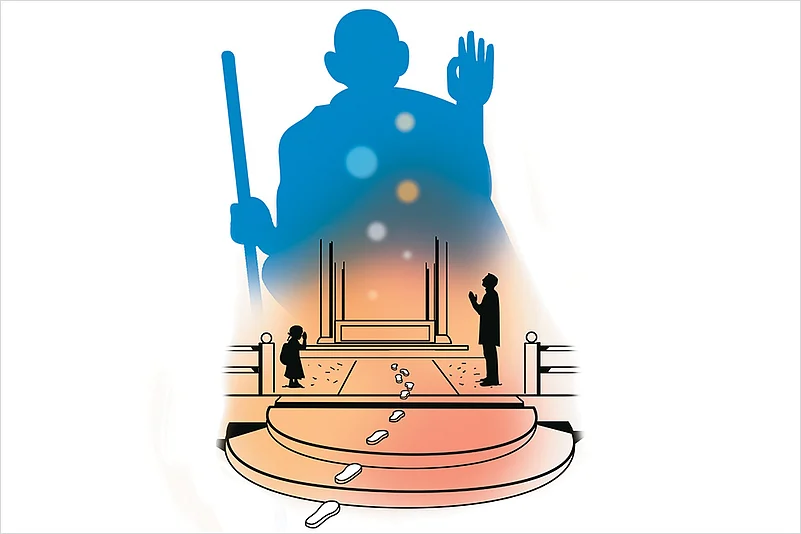Is Gandhi a memory? Or a myth? It was here, on the lawns of Birla House, that Nathuram Godse’s three bullets rang out 70 years ago. They call it Gandhi Smriti now…literally a site for memory. A space where you gather up and display all the scattered signs of a lapsed phenomenon, a presence that has passed. Almost as if to make sure no molecules of its reflection—its spirit—escape into the outside world? Like those city parks where they keep spotted deer behind a fence—an enclosure for forms of life that once roamed free? Even that day, as the Mahatma walked into the back lawn of this mansion, 10 minutes late, among the crowd there were vendors selling his image—he was already being museumised, being turned into something not quite here. An enigma.
Read Also
- Happy R-Day! by Rajesh Ramachandran
- Patriotism Vs Jingoism by Ramachandra Guha
- A Nation Within 4 Temples by S. Gurumurthy
- From Amir Khusrau To Filthy Abuse by Irfan Habib
- Don’t Foist Fear Onto Nationalism by C.K. Saji Narayanan
- 30-01-1948 by Apoorvanand
- Rockbed Of Cultural Renascence by Dr R. Balashankar
What do the people who come here feel? Who comes here? Do they bring awe? Reverence? Or detached curiosity? The other day, they brought a busful of noisy schoolkids—they were in their world of innocent guiles, far from any Gandhian thoughts, says Brij Pal. This is the last January here for the safai karamchari. He’s retiring this month, after 40 years of “rozgaar and Gandhi seva”, a phrase that blends pragmatism and idealism in a way Gandhi would have recognised. Yes, he’s Valmiki by caste—or Harijan. It makes complete sense that Gandhi, who engaged with every social formation in his time, has a Valmiki man—several, actually—to clean his house. Call it continuity, the deep currents of history reclaiming its lands.
It also makes perfect sense that Gandhi Smriti has a guard from Nepal. Vishnu Prasad is a Maddhesi, from the Terai. He too has been a guard here since 1985, and has seen the crowd morph from veterans of the freedom movement coming to weep or pray to the ‘selfie-with-Gandhi’ hordes. “I’ve watched so many come and go that I have a sixth sense about visitors,” says 55-year-old Vishnu Prasad. “From the way they talk, their behaviour, I can tell who will spend a few hours here and who will leave in minutes.” He and Brij Pal too are exhibits at the museum, like Gandhi. Both have that film of benign dust on their faces that only decades of government service can bring. Yet, their backstories, the very terms of their presence here, shine an ironic half-light on the Gandhian project—as revelatory as Gandhi’s well-preserved room in a corner wing that offers the first glimpse into the last 144 days of his life.
Vishnu first saw India as an awe-struck nine-year-old, visiting from Nawalparasi: it was the first World Trade Fair at Pragati Maidan in 1972. A year later he was back, for work. He did better than the lakhs of faceless dhaba boys all over India: someone he knew fixed him up at Rajghat, where he served tea for years, before eventually landing this job. Now, after 30 years of people-watching, he has a sociologist’s eye for nuance. The following portrait of Gandhi Smriti is largely sketched from his impressions.

The museum on Tees January Marg gets 4,000-odd visitors a day. Yet, things have perceptibly changed. “Now foreigners respect Gandhi more. They look at every exhibit, examine each photo. Only some Indians are like them. Most come chiefly to see the spot where Gandhi was killed,” he says. More men come than women, more south Indians than northerners. The rural folk are still moved as if by a numinous presence: they stand before Gandhi’s statue hands folded, heads bowed. Most visitors are from Maharashtra, Gujarat and Kerala. “People from the south often won’t approach Gandhi’s statue with shoes on, even if I tell them they can. Overcome with emotion, some cry and pray.” But if drawn as a cline on a graph, Indians deeply influenced by Gandhi are a fading species.
Brij Pal, dark-haired at 60, is preoccupied with thoughts of retirement. Come February, he will be homeless—“I’ve nowhere to go. Circumstances didn’t permit me to build a home.” He has three daughters (“two married”), a disabled wife, a jobless son. Still, being here was better than serving in a “parchoon ki dukaan” (spice shop)…that would have been soulless. Back in the day, his parents worked for a “laat sahib” in Calcutta. After Class VIII in Moradabad, he landed here: his cousin, already here, tipped him off about a vacancy. An only-Valmiki old boy network? “Gandhi encouraged all to clean. It’s the government that created these posts—cleaner, guard, gardener, electrician….” He’s non-confrontational. It’s like physical proximity to a mahatma has had a pacifying effect. “Whoever comes here will return educated,” offers Vishnu. “I feel it, in this place a great man was killed. It makes me sad, for Gandhi harmed nobody.”
(They talked to Pragya Singh)
















